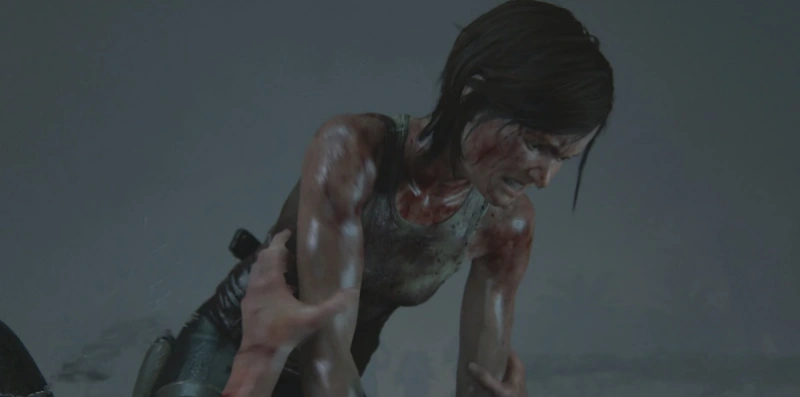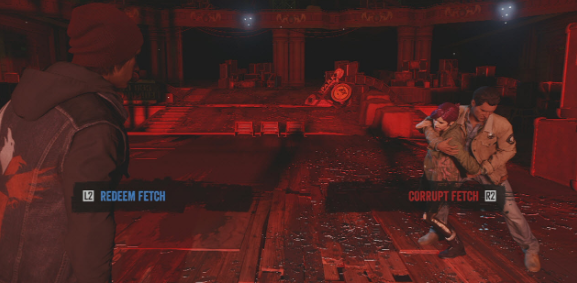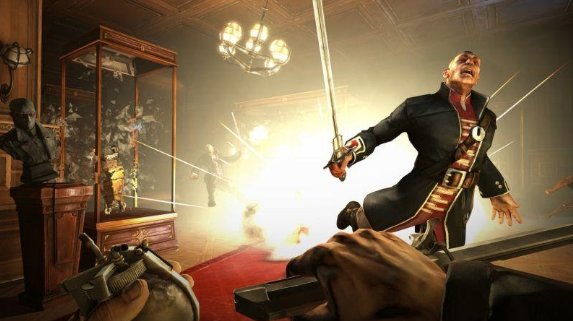Spoilers Throughout
Narrative and Themes
If the premise of Last of Us was Ellie learning from Joel what it takes to "Endure and Survive" like Savage Starlight, its ending was showing what that mindset does to a person. Joel cuts his way through the Firefly facility because the kind of person who makes it that far into a bleak apocalypse using nothing but extreme violence could do nothing else.
What we see with Last of Us Part 2 is what's preventing those same people from ever going beyond "Endure and Survive", stopping them from ever having the opportunity to 'Grow and Thrive'. We see the ramifications of that "Endure and Survive" mindset, the endless cycle of death and revenge driven by individualism at its most extreme, which caps humanity’s potential.
The game opens with us seeing the beginnings of what could truly be a new society; a whole functioning town, children able to have childhoods, structured pair patrols who have the chance to rest, and even the beginnings of a romance where the people involved aren't too afraid of dying to admit it's real. All of that is torn apart when we flip to Abby, arriving like a grim reaper to exact the toll Joel earned from his vicious past. In that moment we see the inevitable end for anyone so consumed with themselves and their world that they forget that every single person they kill on their journey has their own full life of troubles, aspirations, achievements, and loved ones.
The rest of the game is designed to reinforce that theme by showing us Ellie's descent into becoming the very reaper that haunts her, driven by nothing but revenge and an "Endure and Survive" mindset. We then flip over to Abby to show us the opposite, the story of someone finally being convinced that merely surviving isn't enough if there's no one around you and nothing to live for.
Ellie starts out determined to kill but at least has Dina by her side. In the open world of much of Seattle Day 1 you get to spend precious peaceful time with Dina and familiarize yourself with the city. We almost get to feel like actual tourists rather than the "tourists" the WLF sees us as. With the surface level goal of finding Tommy, there's also some space between the actions you're taking and the sole goal of killing everyone associated with Joel's death. Once the truth of Dina's pregnancy is revealed Ellie is pushed out on her own and is forced to face the increasingly dangerous WLF.
When Jesse comes into the picture it seems like things might get better as he explicitly makes her state that she'll be ready to leave when they find Tommy. Despite this, she leaves him with Dina and ventures out on her own once again. Alone with her thoughts and her mission, things rapidly take a turn for the worse. The WLF, Seraphites, and the infected all intensify culminating in a brutal torture sequence where Ellie takes her revenge on someone who unambiguously couldn't fight back.
As Jesse's requests to just get Tommy and leave get for firm, Ellie almost falters but ultimately goes off on her own, almost dying during the storm. Despite that, she arrives at the Aquarium, ready to kill Abby. She instead kills Owen and Mel, something that she finds even more painful than her prior choice to torture Nora. Just as Ellie tries to catch her breath and come to terms with what she's done, Abby arrives and appears to kill both Jesse and Tommy instantly.
Then the switch comes.
When we take control of Abby after she's finally exacted her revenge. Her friends are largely estranged from her after the brutality she displayed, and she's got no real purpose. But, at the same time, we first see the society she's been living in with the WLF. Their base is impressive and even beautiful, something built up so far it could match or even exceed Jackson. There was something worth fighting and living for here with the WLF, but it's something that Abby couldn't focus on and something we literally couldn't perceive or even dream of back when we were playing as Ellie, only able to see the WLF as violent enemy combatants.
This doesn't last long though and we instead soon see one of the WLF's forward bases and get a sense for how tense the fighting with the Seraphites is. Despite this, Abby only really cares about getting to Owen to check on him so she flees, showing she's already starting to prioritize connection over mere survival.
On the way she's captured by the Seraphites and fights her way out with the help of Yara and Lev. This bonds them and leads her to go back to help them after Yara is injured.
At great danger to herself Abby descends into a hospital to retrieve supplies for Yara and successfully saves her life. Abby hopes to go with Owen, Mel, Yara, and Lev to California to start a new life with some remnants of the Fireflies. Unfortunately for her, they're unable to leave because Lev runs away to the Seraphite island in hopes of saving his mother.
Abby, Yara, and Lev fight across the island which results in both Yara dying and Abby starting to kill the WLF members she used to consider comrades to protect Lev and a better, less war-filled future. It's only after she returns to the Aquarium where they had been based out of and finds Owen and Mel killed that she decides to go after Ellie. Even then when she has Ellie dead-to-rights, she chooses to leave her alive once again at the request of Lev.
At the end of her story, Abby has done everything she can to abandon her cruelty and return to the original mission of the Fireflies, rebuilding society so that humanity can once again grow and thrive. It's cost her a lot, prioritizing care for people like Lev and Mel has meant that their harsh world has taken people she cared about but it's also meant that she hasn't perpetuated the cycle of violence to create new enemies.
Abby's story is a version of Joel's where he was still young enough when he met Ellie to change his tune before leaving a sea of bodies in his wake.
In the final chapters we see Ellie in a sort of limbo. She hasn't returned to Jackson or the society it offers. She's still on her own, trying to make it with just her immediate family. For all the beauty they've managed to cobble together, it's a solitary lifestyle that's been unable to heal Ellie in any way that matters. Tommy returns, a ghost from her past and the quest for revenge she's been trying to let go of. His words burrow into her mind and push her to leave the small family she's created behind to finish the job. Wasn't that family what she was supposed to be fighting for?
When Ellie finally shows up, she finds Abby as a shell of her former self. No longer "built like an Ox" the way someone previously described her. All Abby wants to do is take Lev and leave to start to build a world Lev can live in. Ellie can't let her, determined to kill or die trying. Reluctantly Abby gives Ellie the fight she's demanding, both barely able to stand. It's only when Ellie sees a flash of Joel that she lets Abby go. We later learn the memory she had was of the day she finally tried to forgive Joel for what he'd done, a journey of forgiveness they were never able to finish because Joel was killed by his past too soon. Would Ellie kill Abby just to condemn herself to that same fate? Thankfully, no, and it ultimately ends up reframing her journey after Abby as the one that saved Abby's life.
Narrative Design
Story Structure
At the time of its release, a lot of discussion was had about the order of the game's story. By playing as Ellie, a familiar character, and getting all the way to what felt like the end of her story people felt they were unable to care about Abby's story. The alternative proposed was to intersperse the character swapping throughout the story. I'd argue Naughty Dog made the right choice and that without the long stretch as Ellie and Abby, it'd be harder rather than easier to get into the mindset of each character.
Ellie's revenge story works precisely because we only view the WLF as enemy combatants, bumps on the road to end things. Even when Jesse shows up and encourages Ellie to come home to Jackson as soon as they find Tommy, as a player we feel so close to being able to finish our quest that we also want to push that last leg of the way to end Abby. By spending more time as Abby early on, killing her friends as Ellie would only be more unpleasant and uncomfortable. We don't want to care about Abby when Ellie doesn't.
Abby's story works because we get to see her life laid out in its full context very quickly. We see what lead her to the point where she felt she had to kill Joel and we see all the things along the way that were offering her other options. We spend as much time as possible back-to-back with all of the new people they're introducing very quickly to try and build up affection for them. If players felt they were unable to care about Abby's friends, then it was because we spent too much time as Ellie and leaving comparatively little for Abby, not because we play as Abby too late.
Player Agency & Doing The Wrong Thing
Stories where characters do the wrong thing but eventually come around to realizing they're in the wrong are a staple of the narrative landscape. As an audience we can watch and grimace but feel thrilled when we see things turn around.
As a player, things are a bit different. What games have the potential to do is to make you complicit. Unifying the player avatar's emotions and the player's emotions such that when the journey changes the avatar it also changes the player's perspective on themselves.
Last of Us Part 2 almost succeeds in doing that by letting us steep in Ellie's perspective for the first half of the game and making the WLF seem so inhuman. When characters surrender, if you let them live, they'll invariable turn on you forcing you to kill them which encourages you to preemptively kill them going forward. When dogs who you might care deeply about in other contexts hunt you down and pounce on you it trains you to think of them as nothing more than a particularly annoying enemy type. This is pulling you deeper and deeper into that "Endure and Survive" mindset, even if you're aware that the situations are manufactured to do just that.
All of this sets you up for the script to be flipped with Abby. Even if you see it coming, the depth of the sense that everyone truly has their own lives comes into focus. It's a perspective you could never get in real life as you'll never be able to fully live as someone else for their formative years and their own quest. Some have said they wish Abby's perspective better mirrored Ellie's, but that entirely separate quest is the point.
Where Last of Us Part 2 fails for me is in the final chapter, where (in my estimation) any reasonable person would understand that Ellie is making the wrong choice by going back to finish Abby off. We know she's tortured by Joel's death, but we weren't the ones raised by him. We know she has a new family that is begging her to stay. We know that Abby has turned over a new leaf and has no interest in perpetuating the cycle. Such a turn, while understandable for Ellie, isn't in line with what we as the player feel. While this would still be fully within the realm of "in character" and "plausible" for a film, it forces us as players to act functionally against our will. It starts out alright, the infected and Rattlers are universal enemies and the desire to at least find out what happened to Abby, to inadvertently be her savior, pulls you along. It's only once you finally find Abby and are forced to beat her to a pulp as she tries to leave that you're invariable left waiting for Ellie to wake up. It was in this moment that I even hopped I could let Abby beat me so she could just leave but I was simply respawned as with any other video game death and forced to keep fighting.
Having both good examples and bad examples of this space for player emotional union in one makes for a good study for the future and is an admirable attempt from Naughty Dog to do something that's rarely attempted by AAA studios.
Other Thoughts
Seraphites
The Seraphites filling the role of "Indians" for a "Cowboys and Indians" story in what was always thematically a bit of a western was a smart inclusion. There are political implications about how they're depicted in relation to the WLF but as a story more interested in drawing from the flavor of westerns than redefining them, I think it does the job.
Final Chapter
While the entire final chapter does feel like the start of a whole separate story, there's some value in that to reinforce the idea that Ellie is truly going on a whole new unnecessary adventure just to get her revenge. Trying to develop a new opposition gang (in the form of The Rattlers) right at the end is a bit controversial as well but they were also a necessary plot device to get Abby where they needed her for the finale and had more development than the Hunters from the original game. There might be a version of the game where Abby and Lev are instead living closer to Seattle and were recaptured by what was left of the WLF or Seraphites. This would have Ellie descending back into it, essentially going backward in her life, to finish the job. That might've worked as well and left fewer people conflicted but it also likely would've interfered with Abby's story of leaving entirely to pursue the Fireflies as well as the artistic opportunity to render a whole new city. Definitely a tradeoff with no easy answers.
Meta-Discussion
The message of the game seems to have been a bit too bold for its own good. While I and many others have taken a favorable reading of it, large chunks of the fanbase haven't.
This includes people who read Joel's initial outing as one that redeemed him rather than one that ultimately condemned him. For them Joel dying at the beginning of Part 2 was unforgiveable rather than merely a motivating inciting incident. It also placed their emotional center far closer to Ellie than was healthy and led them to want to finish Abby off in the finale. This might speak more to media comprehension than the narrative but some amount of extra effort portraying Joel's behavior as reprehensible might have got them in line.
This also includes the folks that read the story only as a story about how harmful the cycle of violence is and found that theme to be ludonarratively dissonant against the extreme violence that Ellie perpetrates. I suspect that this camp may have overanalyzed that segment of the game where the player was, in fact, meant to be motivated to kill. Just because the killing is gruesome and bleak, doesn't mean we're not meant to feel it's justified or even satisfying. Those are the feelings Ellie had and it's okay that they're the feelings the player might have. Perhaps leaning farther into how the WLF gave Ellie no choice in their engagements (separate from Ellie having a choice between engagements) would have helped there.
Ultimately, I think it was a very fine tightrope to walk and the game did just about the best it could doing it but may have been hamstrung by the sheer number of people that were meant to understand both sides of the coin that were fundamentally emotionally opposed.
















